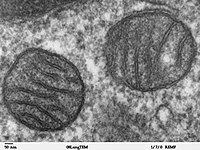
Photo from wikipedia
A number of mitochondrial diseases arise from single-nucleotide variant (SNV) accumulation in multiple mitochondria. Here, we present a method for identification of variants present at the single-mitochondrion level in individual… Click to show full abstract
A number of mitochondrial diseases arise from single-nucleotide variant (SNV) accumulation in multiple mitochondria. Here, we present a method for identification of variants present at the single-mitochondrion level in individual mouse and human neuronal cells, allowing for extremely high-resolution study of mitochondrial mutation dynamics. We identified extensive heteroplasmy between individual mitochondrion, along with three high-confidence variants in mouse and one in human that were present in multiple mitochondria across cells. The pattern of variation revealed by single-mitochondrion data shows surprisingly pervasive levels of heteroplasmy in inbred mice. Distribution of SNV loci suggests inheritance of variants across generations, resulting in Poisson jackpot lines with large SNV load. Comparison of human and mouse variants suggests that the two species might employ distinct modes of somatic segregation. Single-mitochondrion resolution revealed mitochondria mutational dynamics that we hypothesize to affect risk probabilities for mutations reaching disease thresholds.
Journal Title: Cell reports
Year Published: 2017
Link to full text (if available)
Share on Social Media: Sign Up to like & get
recommendations!